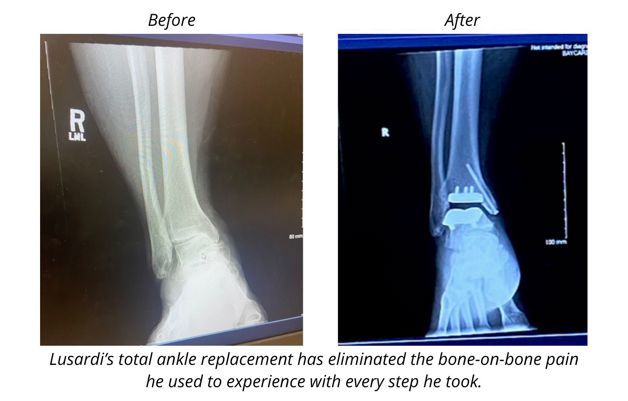
Jim Lusardi will get to explore the world in a new way this year on his new right ankle. The 56-year-old had his second ankle replacement with Dr. Brandon Scharer, a foot and ankle surgeon at Orthopedics & Sports Medicine BayCare Clinic, late last year in anticipation of a cruise he and his wife had planned.
“I’m looking forward to not holding back or saying, ‘You go ahead, it looks fine from here,’” Lusardi said.
Reflecting on a previous vacation, Lusardi remembers his bone-on-bone ankle pain made Mayan ruins extremely difficult to tour.
“You’d have 200 steps you’re trying to climb, and it takes you an hour when everyone else is up and back in ten minutes.”
Ankles Had Been in Disrepair for Years
Scharer also replaced Lusardi’s left ankle in December 2020. Years of playing football, basketball, and racquetball had taken their toll. Lusardi had a ligament reconstruction 18 years ago and was getting joint injections regularly to manage the pain. But even with most of that activity in his past, Lusardi’s ankles weren’t holding up daily.
“I fell over once just stepping out of the car and I almost hit my head,” Lusardi said. “So it was like, ‘Yeah, we gotta do something about these.’”
Jim’s Path to Total Ankle Replacement
Lusardi appreciates the way Scharer patiently listened to him the first time he got an injection from Scharer. After a few injections, Lusardi said Scharer helped him understand they were just a temporary fix, not a true solution to the problem. 
“He made me at ease with those conversations,” Lusardi said. “And understanding what was actually happening, what my options were, and just explaining it all.”
The relationship Scharer built with Lusardi helped him decide to get his left ankle replaced in 2020. The success of that ankle replacement set Lusardi on a path to say yes to replacing his right ankle in 2023 without hesitation.
“I woke up from surgery with less pain than I was in prior to surgery,” Lusardi said. “Sure, you’ve got medications and some surgical pain to deal with, but it’s a different type of pain versus the bone-on-bone grinding.”
Lusardi highly encourages others with ankle issues to get them checked out.
“If you’re living with that type of pain, seek the help. It’s not going to get better, odds are, unless you get it looked at. And then find out what your options are. When you see the imaging and understand where the pain’s coming from, that does help make the decision easier.”